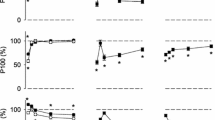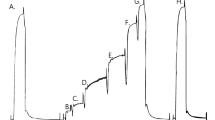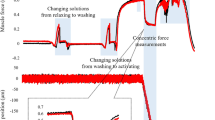Summary
Eccentric and posteccentric force behaviour in human skeletal muscle and in isolated frog muscle fibres was studied by imposing stretch-and-hold loading conditions during contractions with maximal voluntary effort or under tetanic stimulation in the isolated preparations. The investigations on human muscle were made on the forearm flexors of a group of kayak racers (n = 16; age: 17–22 years) and of schoolgirls (n = 15; age: 17–18 years) with both groups participating in a strength-training programme over 4 (kayak racers) or 3 (girls) months. Half of the training regime consisted of eccentric elements. In the isolated muscle fibres, it could be shown that in the posteccentric hold phase the enhanced force decayed exponentially to the original isometric value with a mean time-constant of 0.35 s (10°C) and of 0.23 (20°C). In the forearm flexor of human subjects similar results were obtained not only qualitatively but even quantitatively (time constant of posteccentric force decay: 0.25–0.37 s). Strength training in both groups did not lead to an enhancement in maximal isometric force alone [mean increase in force 17 (SD 10)%], a well-known and generally accepted fact, but also to a parallel shift in eccentric [21 (SD 10)%] and posteccentric force level. The close similarity between the findings in isolated muscle fibres and in human muscle in situ suggests that the eccentric and posteccentric behaviour must be primarily ascribed to the contractile properties of the muscle fibres themselves. A three-element muscle model with variable visco-elastic properties would appear to be most suitable for simulating the experimental findings.
Similar content being viewed by others
References
Asmussen E, Bonde-Petersen F (1974) Storage of elastic energy in skeletal muscles in man. Acta Physiol Scand 91:385–392
Bigland B, Lippold OCJ (1954) The relation between force, velocity and integrated electrical activity in human muscles. J Physiol 123:214–224
Bober T, Jaskólski E, Nowacki Z (1980) Study of eccentric-concentric contraction of the upper extremity muscles. J Biomech 13:135–138
Bouisset S, Goubel F (1973) Integrated electromyographical activity and muscle work. J Appl Physiol 35:695–702
Cavagna GA, Dusman B, Margaria R (1968) Positive work done by a previously stretched muscle. J Appl Physiol 24:21–32
Chapman AE, Caldwell GE, Selbie WS (1985) Mechanical output following muscle stretch in forearm supination against inertial loads. J Appl Physiol 59:78–86
Cnockaert JC (1978) Comparison of the potential elastic energy stored and used by two antagonistic muscular groups. Eur J Appl Physiol 39:181–189
Curtin NA, Davies RE (1972) Chemical and mechanical changes during stretching of activated frog skeletal muscle. Cold Spring Harbor Symp Quant Biol 37:619–626
Délèze JB (1961) The mechanical properties of the semitendinosus muscle at lengths greater than its length in the body. J Physiol 158:154–164
Dietz V, Noth J (1978) Pre-innervation and stretch responses of triceps brachii in man falling with and without visual control. Brain Res 142:576–579
Dietz V, Noth J, Schmidtbleicher D (1981) Interaction between pre-activity and stretch reflex in human triceps brachii during landing from forward falls. J Physiol 311:113–125
Edman KAP (1966) The relation between length and active tension in isolated semitendinosus fibres of the frog. J Physiol 183:407–417
Edman KAP, Elzinga G, Noble MIM (1978a) Enhancement of mechanical performance by stretch during tetanic contractions of vertebrate skeletal muscle fibres. J Physiol 281:139–155
Edman KAP, Elzinga G, Noble MIM (1978b) Further characterisation of the enhancement of force by stretching during activity in single muscle fibres of the frog. J Physiol 280:35–36P
Edman KAP, Elzinga G, Noble MIM (1981) Critical sarcomere extension required to recruit a decaying component of extra force during stretch in tetanic contractions of frog skeletal muscle fibres. J Gen Physiol 78:365–382
Fenn WO (1924) The relation between the work performed and the energy liberated in muscular contraction. J Physiol 58:373–395
Flitney FW, Hirst DG (1978) Cross-bridge detachement and sarcomere ‘give’ during stretch of active frog's muscle. J Physiol 276:449–465
Gasser HS, Hill AV (1924) The dynamics of muscular contraction. Proc R Soc B 96:398–437
Gordon AM, Huxley AF, Julian FJ (1966) The variation in isometric tension with sarcomere length in vertebrate muscle fibres. J Physiol 184:170–192
Gottlieb GL, Agarwal GC (1979) Response to sudden torques about ankle in man: myostatic reflex. J Neurophysiol 42:91–106
Gülch RW, Fuchs P, Schultheiß S, Heitkamp H-Ch (1989) Comparative investigations of the posteccentric potentiation in muscle groups of man and in isolated muscle fibres. In: Böning D, Braumann KM, Busse MW, Maassen N, Schmidt W (eds) Sport — Rettung oder Risiko für die Gesundheit. Deutscher Ärzte, Cologne, pp 68–73
Hill AV, Howarth JV (1959) The reversal of chemical reactions in contracting muscle during an applied stretch. Proc R Soc B 151:169–193
Huxley AF (1957) Muscle structure and theories of contraction. Prog Biophys Biophys Chem 71:255–318
Joyce GC, Rack PMH (1969) Isotonic lengthening and shortening movements of cat soleus muscle. J Physiol 204:475–491
Komi PV, Bosco C (1978) Utilization of stored elastic energy in leg extensor muscles by men and women. Med Sci Sports Exerc 10:261–265
Kuroda E, Klissouras V, Milsum JH (1970) Electrical and metabolic activities and fatigue in human isometric contraction. J Appl Physiol 29:358–367
Levin A, Wyman J (1927) The viscous elastic properties of muscle. Proc R Soc B 101:218–243
Ramsey RW, Street SF (1940) The isometric length-tension diagram of isolated skeletal muscle fibres of the frog. J Cell Comp Physiol 15:11–34
Schmidtbleicher D (1984) Sportliches Krafttraining und motorische Grundlagenforschung. In: Berger W, Dietz V, Hufschmidt A, Jung R, Mauritz K-H, Schmidtbleicher D (eds) Haltung und Bewegung beim Menschen. Springer, Berlin Heidelberg New York, pp 155–188
Sugi H (1972) Tension changes during and after stretch in frog muscle fibres. J Physiol 225:237–253
Thomson DB, Chapman AE (1988) The mechanical response of active human muscle during and after stretch. Eur J Appl Physiol 57:691–697
Van Atteveldt H, Crowe A (1980) Active tension changes in frog skeletal muscle during and after mechanical extension. J Biomech 13:323–331
Author information
Authors and Affiliations
Rights and permissions
About this article
Cite this article
Gülch, R.W., Fuchs, P., Geist, A. et al. Eccentric and posteccentric contractile behaviour of skeletal muscle a comparative study in frog single fibres and in humans. Eur J Appl Physiol 63, 323–329 (1991). https://doi.org/10.1007/BF00364457
Accepted:
Issue Date:
DOI: https://doi.org/10.1007/BF00364457




